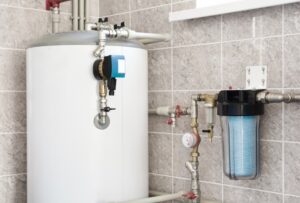A new water heater costs many hundreds of dollars. Depending on the type and model, it can even cost two thousand or more. And that’s before you’ve gotten it installed. If you’re switching fuel sources or changing between a tank and tankless model, installations can be time-consuming and complex … and thus, they can be costly.
You’d really rather not have to replace your water heater. You’d like it to last for a long time! What can you do to keep your water heater running for as many years as possible? Have water heater flushes done regularly! Here’s why.
Sediment
Sediment is made up of the particles that settle out of water, the way that sand or silt settle out of a body of water and end up at the bottom of the pond or lake. Now, of course, the water coming into your home isn’t nearly as dirty as pond water! But just think about how much water passes through that water heater.
According to OSTI, the US government’s Office of Scientific and Technical Information, the average American household uses 63 gallons of hot water every day. That’s almost 23,000 gallons a year! Even if there was only one speck in each gallon, twenty-three thousand specks would add up to a pile of sediment.
Sediment accumulates at the bottom of the water heater’s tank. It reduces the space for water in the tank. The remaining water can end up with temperature or pressure issues because of the lack of space. Some water can become trapped in the sediment at the bottom and overheat. This all increases wear and tear on the whole system, forcing you to get water heater repair from a plumber in Warrington, PA.
Scaling
Scaling is the result of minerals being deposited from your water. All water contains some amount of minerals. Hard water, which is still perfectly safe to drink, contains higher-than-usual levels of things like calcium, magnesium, and iron.
Minerals being deposited from water is how stalactites and stalagmites are created. Over time, even when the water isn’t unusually high in minerals, stony layers are laid down wherever the water has been. This mineral scaling is pretty cool to see in a cave, but you don’t want it happening in your water heater.
Mineral scaling can build up on the inside of a water heater’s tank. Whether you have a tank system or a tankless one, mineral scaling will build up in the water lines connected to your water heater. Gradually, this will narrow the lines more and more. Your hot water pressure will decrease until you just can’t get enough to keep your shower warm.
Not only that, but the water heater will be struggling. That same scaling will be layering itself over the heating elements, acting as insulation, preventing the heat from reaching the water. To get to the same temperature, the water heater will have to work much harder, and again, this will lead to system strain, more frequent repairs, and a shorter lifespan for the water heater.
Have Your Water Heater Flushed
Once a year, as part of regular household maintenance, have a qualified plumber come to flush your water heater. Sediment and scaling will be washed away, and your water heater will work better and last longer.
Contact Platinum Plumbing & Heating, Inc. today to schedule an appointment with our pros.

